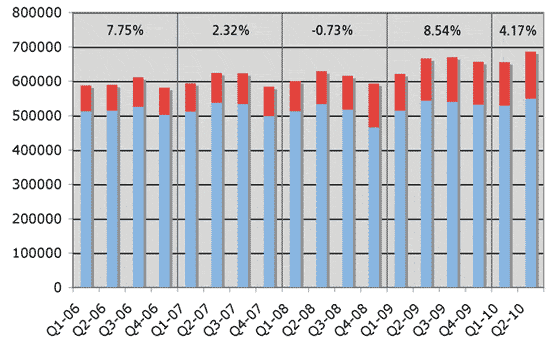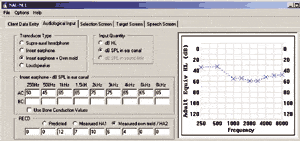
According to Hearing Industries Association (HIA) statistics, US net hearing instrument sales increased by 2.93% to 686,165 units during the second quarter of 2010; however, private sector sales (ie, disregarding VA activity represented by red bars in the graph below) increased by only 0.97%. These figures represent a slight decelleration from the first quarter, when unit volume growth was 5.51% and 2.74%, respectively. When comparing the first half of 2010 to 2009, sales for this year have increased by 4.17% overall and 1.84% for the private sector. VA dispensing activity has continued at a brisk (albeit, no longer record-breaking) pace, with unit volumes increasing by 14.96% in the second half on top of 25% gains in the first half of 2009.
It’s tempting to think that the slightly lower percentages for the private sector in the second quarter are the result of last year’s market recovery from the nation’s deep ecomonic recession of 2008. However, the recession’s effect on hearing instrument unit volumes was relatively mild, and the private sector made only modest gains (0.43% and 1.82%) in the first two quarters of last year (see below); the bulk of the hearing industry’s “recovery” occurred in the last two quarters of 2009 (4.27% and 14.09%)—which contributed sizably to the overall yearly market gain of 8.54%.
If the hearing industry really is a bellweather for the national economy, as some have speculated, what the latest HIA figures suggest is “more of the same” for the remainder of the year. In fact, due to the higher percentage sales increases witnessed in the second half of 2009 (particularly Q4), unit sales may appear to be flat and/or even negative in the second half due to the late-2009 surge (re: same quarters) shown below.

What is not flat is the consumers’ and dispensers’ continued reliance on BTE technology to solve hearing problems. During the first half of this year, more than 2 of every 3 (67.12%) hearing aids sold in the private sector were BTEs compared to 64.13% in the first half of 2009, reflecting the growing popularity of open-fit BTE instruments. BTEs that feature external receivers (eg, RIC/RITE) accounted for 28.23% of all private sector hearing aid sales during the second quarter—essentially unchanged from the second quarter of 2009 (28.49%).
The data from HIA suggests that the return for credit (RFC) rate in the second quarter was 18.78%, with about 1 in 5 (20.28%) BTEs and about 1 in 7 (15.71%) ITEs being returned to manufacturers.
Karl Strom
Editor-In-Chief





